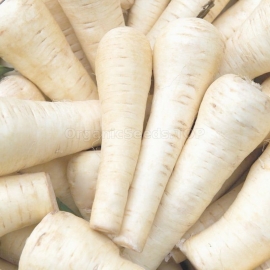



«Pulse» - Organic Parsnip Seeds
1.14 €
A real storehouse of vitamins and mineral salts. The use of parsnip in food improves appetite, digestion, strengthens the walls of blood vessels, increases potency. They sow in the early spring with a row spacing of 45 cm to a depth of 2.5-3 cm.
-
Heirloom Parsnip «Pulse»
A real storehouse of vitamins and mineral salts. The use of parsnip in food improves appetite, digestion, strengthens the walls of blood vessels, increases potency.
They sow in the early spring with a row spacing of 45 cm to a depth of 2.5-3 cm. It requires timely thinning. The final distance between the plants is 10-15 cm. Biennial plant. In the first year of life forms a fleshy root crop, rounded-flattened or conical, which is used for food.
How to Grow
It takes from 120 to 180 days for a parsnip to go from seeds to roots. When planting parsnips, plant the seeds ½-inch apart and ½-inch deep in rows at least 12 inches apart. This gives the growing parsnips room to develop good roots. Growing parsnips takes 18 days for germination. After seedlings appear, wait a couple of weeks and thin the plants to about 3 to 4 inches apart in rows.
Water parsnips well when growing parsnips or the roots will be flavorless and tough. Fertilization of the soil is also helpful, and you can fertilize your growing parsnips the same way you would your carrots. Side dress with fertilizer around June to keep the soil healthy enough for growing parsnips.
After 120 to 180 days, you’ll know when to harvest parsnips because the leafy tops reach to 3 feet tall. Harvest parsnips throughout the row and leave others to mature. Parsnips keep well when stored at 32 F. (0 C.). You can also leave some of the parsnips in the ground until spring; just throw a few inches of soil over your first fall crop of parsnips to insulate the roots for the coming winter. When to harvest parsnips in the spring is right after the thaw. The parsnips will be even sweeter than the fall harvest.
